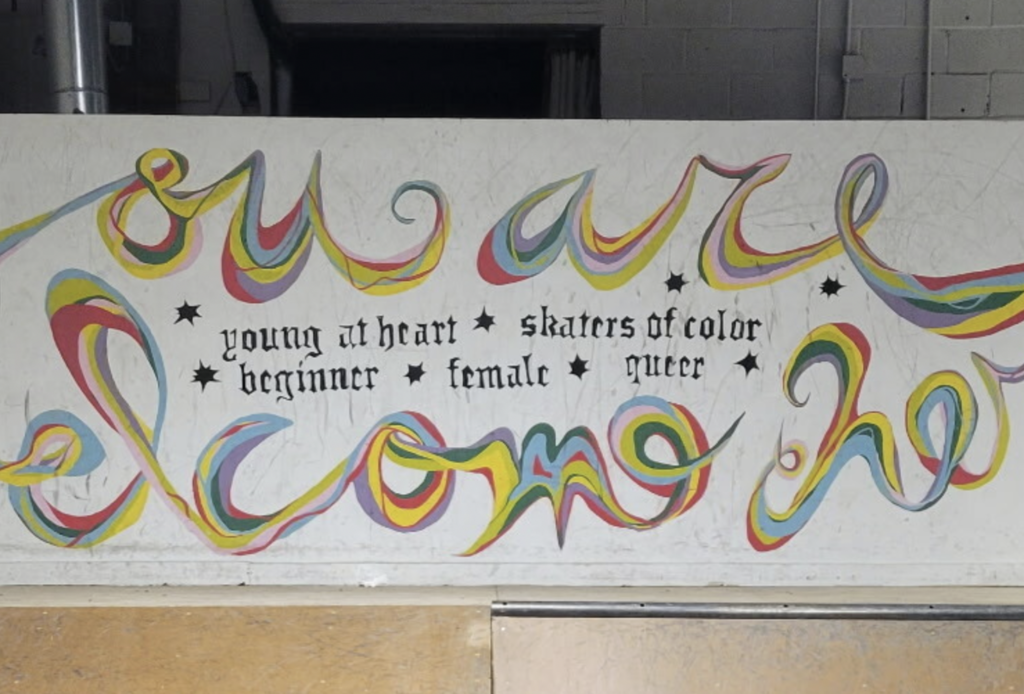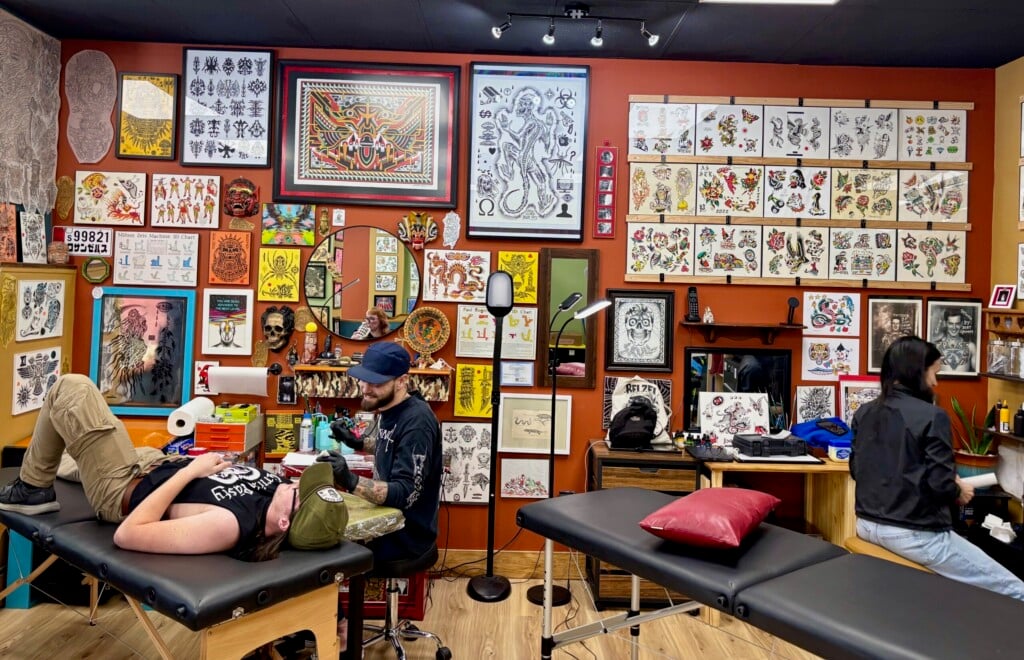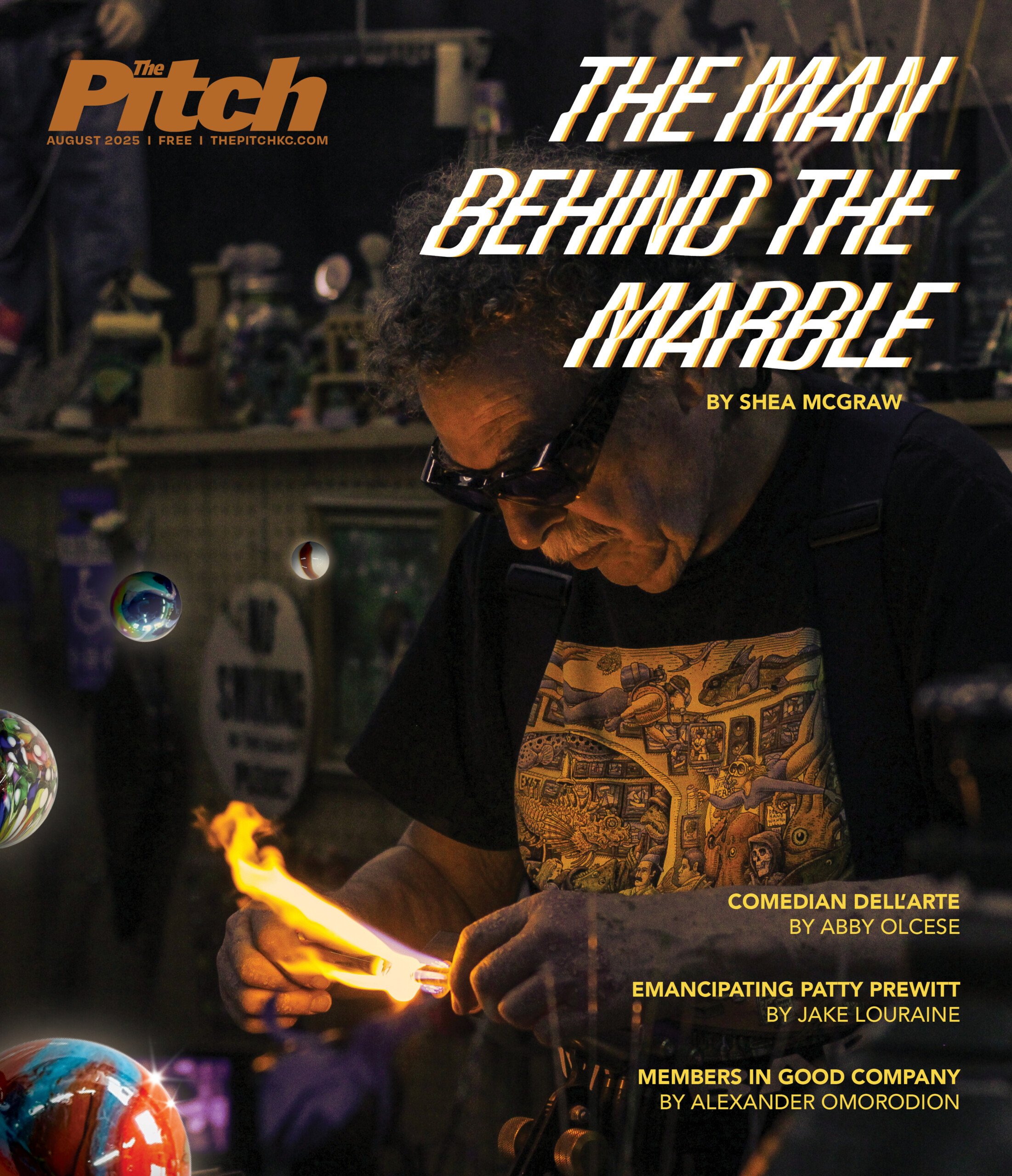Movin’ On Up

Police officers Paul Luster and Mike Eickman turn onto 55th street and see a flash of money. Two men on the sidewalk glance up at the white cop car and take off in separate directions. Luster hits the gas and wheels the car around. “Now we have to choose,” he says. “I hope we get the dealer.”
The chosen one heads for Highland Avenue, walking at an even pace. He peers over his shoulder, turns his back, reaches into his pocket and turns again to show he is lighting only a cigarette. In one swift motion, Luster parks the car at an angle to the curb, slams home the gearshift and opens his door. The suspect flinches as the officers approach him rapidly. “I thought you guys were going to shoot me,” he says, shaking.
Eickman grabs an opened 22-ounce bottle of St. Des kiwi strawberry malt liquor from the man’s hand and frisks him. The cop snaps cuffs around the man’s wrists and lowers him to his knees on the sidewalk. It’s late afternoon on a Friday. A block to the west, former mayor Emanuel Cleaver’s church, St. James Paseo United Methodist, blocks the flagging sun, throwing a cold shadow on the scene. A tinny voice sounds from Eickman’s portable radio. The suspect’s name is Ronnie. This is his second bust of the month. Last time, it was for cocaine.
Eickman fishes a moistened wad of brown paper towel from Ronnie’s shirt pocket. A pinch of marijuana hides in the paper’s folds, more seeds and stems than leaves. Next comes a broken cigarette. Then a scrap of tightly wrapped cellophane containing a tiny clump of powder the size and color of a garbonzo bean.
“That’s nothing,” Ronnie protests. “It’s no good. I found it on the ground outside Paul’s.”
Same thing with the weed, Ronnie says — it had been a freebie just waiting there on the ground. Luster thinks this is unlikely. The owner of Paul’s Liquor & Grocery, located across Paseo from St. James, has a low tolerance for crime. Hard to believe he would let his parking lot become a free-drug bin. “So you got busted for coke,” Luster says. “They want you to go to [addiction recovery] classes. Why you going around picking up dope?”
“I don’t know. It was stupid.”
“Yeah, it’s stupid. It’s so stupid, in fact, that I’m not buying it.”
Ronnie’s eyes are wide. “The stuff’s no good,” he says meekly. “Are you going to let me go?”
“No,” Eickman scoffs. “You’re going to jail.”
Eickman and Luster are never lenient with drug offenders. Not in this neighborhood. Four days a week the two prowl the streets of Blue Hills, a stretch of more than 3,000 households lining up from the shady Paseo on the west to the littered gutters of Prospect on the east, from the young grass of Brush Creek Parkway on the north to the bustle of 63rd Street on the south. In a bygone era, Eickman and Luster would have been called beat cops. Today they’re Community Action Network — CAN — officers. Luster, who has worked this area the better part of a decade, says Blue Hills used to be a “war zone,” one of the most drug-infested sectors of Kansas City. These days the drug trade is a meager open-air market shifting from corner to corner, bust to bust. Today 55th and Highland is a mini hot spot, just a sniff away from Cleaver’s church.
“This is not good,” Ronnie wails. “I can’t go to jail.”
Shackled, he kneels a dozen steps away from his own front door. One by one, his neighbors come home from work. The woman who lives across the street from Ronnie creeps by in a wide sedan, craning her neck to see who’s been caught. She pauses in her driveway and then again on her porch for a longer look. A man about Ronnie’s age, in his late twenties, pulls up and steps out of a van, half glancing at Ronnie while unloading his tools. An older man wearing a security guard’s uniform parks in front of a police van that has arrived. He steps past Ronnie on the sidewalk, eyeing his neighbor peripherally, not saying a word.
These people are the new warlords of Blue Hills.
In 1969, the Atkinson family migrated south from a neighborhood near the old Municipal Stadium to a turn-of-the-century country estate in Blue Hills. Surrounded by the smaller yet robust brick-and-stone bungalows built in the halcyon 1920s, their new house rose high on a small hilltop — two stories with a windowed attic and a two-column porch. In the eyes of their daughter B.J., who was not quite in her teens, it was a palace. “Being young, I thought it was the greatest thing in the world,” she says. “It was just like ‘The Jeffersons’ — movin’ on up.”
But B.J. also noticed “for sale” signs planted up and down her block, stabbed into the ground by the white families who had populated Blue Hills for decades. From her porch she could see the family that lived across the street, their children romping around on the front lawn. She longed to join them, but they’d never given her so much as a welcoming smile. “I knew better than to ask them to play,” she says.
She was walking home from school one day with a friend when they spotted two good-looking white boys cruising in a red convertible with the top down. “We just thought we were too cute. We were just teenage girls, you know, and we smiled at them,” she recalls today, pausing to lower her voice. “And then they yelled ‘nigger’ and all sorts of awful obscenities at us.”
Real-estate agents thrived on this sort of hatred. Some were proud of their work. A neighborhood priest remembers one broker who trolled the streets in a Volkswagen Beetle with a couple of coffee cans full of house keys on the back seat. He boasted that he was “converting” the neighborhood. These profiteers would quietly sell homes to black families, then, playing on fear, turn around and leaflet the white neighbors’ houses with offers to help them sell. Often they would list the home of a white family, then stall the sale when the owners began the process of buying a new home in a whiter neighborhood. When a homeowner fretted because his Blue Hills home hadn’t sold, the agent would step up with a check, offering to relieve the burden at a tremendous markdown.
Prices were already low because red-lining continued through the ’60s. The Federal Housing Administration labeled neighborhoods such as Blue Hills “transitional” and would not back home loans for white buyers.
The Atkinsons were solidly middle class — B.J.’s mom was a nurse and her dad had a stable job with the Postal Service. But with the neighborhood’s decimated real-estate market, the population of Blue Hills became progressively poorer. Family-owned homes turned into rentals and withered from lack of care.
The U.S. government hastened the decay. In the late ’70s, Blue Hills hosted Kansas City’s first scattered-site Section 8 housing development — a cure-all devised by bureaucrats in the Carter administration to reverse the damage created by the massive, self-contained housing projects of earlier decades. Section 8 aspired to economic integration, but here in Kansas City, responsibility for the first project fell into the hands of an out-of-town landlord. With financial assistance from the city, state and federal governments, this businessman, Gerald Radtke of Naples, Florida, gained title to more than a hundred properties, most of them in Blue Hills. In the ensuing years, city, state and federal officials filled file cabinets with documented code violations on Radtke properties — sagging roofs, punctured floors, clogged plumbing, exposed hot wiring, rodent and insect infestation and even a dead body kept alive on paper so Radtke could go on receiving the government’s rent check. The feds failed to cut off Radtke’s money flow until 1998.
Even the Atkinsons’ new church suffered. With its membership dwindling, the congregation of St. Therese Little Flower Church, under the guidance of Father Norman Rotert, sought to help its ailing neighborhood.
Rotert and his colleagues won a city grant to buy run-down houses and fix them up for resale. In July 1974, they created the Blue Hills Home Corporation, a nonprofit with officers and a board of directors.
They claimed a house on the corner of 58th and Garfield, buying it on the steps of the Jackson County courthouse for $500. And they commenced remodeling. “We didn’t know what we were doing,” Rotert says. “Everybody on the board was an interior decorator. It took more than a year to do one house.”
They put $13,000 into the rehab, only to have the house appraised by the Federal Housing Authority at $11,500. “All of a sudden, the board went away and I was left holding the notes,” Rotert says. Facing a $2,000 deficit, he enrolled in school to learn how to become a real-estate broker. When he got his certificate, he wrote his own appraisal for $13,000 — which was upheld by a different FHA appraiser. The house sold immediately.
Blue Hills Homes Corporation was one of the first community development corporations in Kansas City. Such nonprofits administer federal funds for citizens who want to improve their neighborhoods; their formation signified a slowly evolving shift in government policy. Today, CDCs rule urban redevelopment because federal officials have moved away from sweeping top-down solutions for problems. CDCs lean heavily on input from neighborhood leaders, and their projects are successful more often as a result.
Rotert and his colleagues in the Blue Hills Homes Corporation continued fixing up houses, picking up federal grants here and there but mostly scraping for funds. “We just kind of begged, borrowed and stole money when we could get it, mostly from family and friends,” Rotert says. Gradually, the ambience of Blue Hills brightened. “Home rehab was contagious,” Rotert says. “The program gave people hope. And that hope was being fulfilled until the drug problem hit. And when the drug problem hit, it became the destroyer of the neighborhood.”
Gunshots every night. That’s how every resident who lived through the crack epidemic describes the neighborhood as it was in the late ’80s and early ’90s. “Everything that was bad was Blue Hills,” says Terry Riley, who worked in Blue Hills for Americorps during the height of the epidemic and is now a city councilman. “We used to call Blue Hills Park ‘Gang Park.’ It had gunshot holes in the backboard.”
The neighborhood was pocked with hundreds of crack houses. Two were across the street from St. Monica Elementary School, which adjoins St. Therese. The owners had abandoned them years earlier. Plywood had been nailed over the broken boards that once covered busted windows. In Blue Hills, thugs who got high on crack in an abandoned house and got an itch to destroy something would smash open window frames to free the window’s weights, then hurl them like decathlon hammers. It was interior decorating for the drug set, a clan at home in filth. The more run-down a house was, the more appealing it was to drug dealers. And the two houses across the street from St. Monica Elementary were among the worst in Blue Hills.
One day in 1992, a St. Monica staffer who’d arrived early to unlock the school found a dead body splayed on the front steps. From then on, the houses became targets of a holy war. For months they’d languished on the city’s demolition list, waiting for city hall functionaries to trudge through their backlog.
Residents held an “action” at St. Therese. They invited city officials and people from other churches around town (all of them members of a still-young grassroots group called the Church Community Organization that had been started at St. Therese in the late ’70s). After a prayer and a round of chilling testimonials, they asked the city officials to commit right there to tear the houses down.
The battered shacks went to the top of the city’s demolition list. In their place came first a playground, then two new classroom buildings for St. Monica Elementary.
The victory instilled confidence among the people of Blue Hills. “Before that, we were like settlers circling the wagons trying to repel the outside attackers,” Atkinson says. “But then when we pushed a few of them back, we realized we could not only defend; we could go on the offensive and start gaining back some of our neighborhood.”
James Jones had moved into Blue Hills in 1963 and loved it from the start. Back then, healthy businesses thrived along Prospect — a neighborhood dime store, a clothier, several clean family restaurants. The supermarket anchoring the Metro Plaza at 63rd and Paseo was one of grandest in the city, twice the size of the Thriftway that’s there today. At 63rd and Troost was the Landing, then a prosperous upscale mall linking Kansas City’s east and west sides. Now a discount outlet, the Landing first held a Macy’s, then a Dillard’s. On Saturdays, its massive parking lot was packed. “Livable, beautiful,” Jones says of Blue Hills. “Right in the center of things. It was ideal.”
But Jones was out of town for much of the next three decades, running the highways as a trucker. When he stopped working in the mid-’90s, he realized he might as well have retired in war-torn Beirut. “It almost seems like I woke up one day, and the whole neighborhood had changed,” he says. “I found myself inside a drug-infested community. There were shootings every night. Gunfire. You couldn’t sleep. I mean it was terrible. Senior citizens were afraid to sit on their porches. Drug dealers were tearing down the streets at fifty, sixty miles an hour.”
Disgusted, he attended a neighborhood-association meeting. “Like most organizations, the women run it,” he says. But he spotted a few men there and chatted them up. “I said, ‘Let’s see how many men we can get together and see what can be done about this. Just a man’s meeting.'”
A month later they gathered at the Metro Police Station, midway between Prospect and Paseo on 63rd. A couple dozen men showed up. “We weren’t a hundred at the time, but we hoped we would be,” he says. So, in the Louis Farrakhan vernacular of the time, they dubbed themselves the “100 Men of Blue Hills.” The men, most of them retired like Jones, organized and appointed officers. They devised uniforms — black pants, black berets and white T-shirts with the group’s logo on the front.
Their first drug march was on the Blue Hills Apartments, a no-frills arrangement of boxy buildings on the neighborhood’s southern border. “No more drugs! No more crack!” they shouted. “We’re here to take our neighborhood back!” The marches became a routine. Most dealers retreated, but some retaliated, hurling bricks and firing bullets through Jones’ windows. “It’s scary at times,” he says, but it didn’t phase him. “We’re doing the intimidating. We’re not going to let them intimidate us.”
The 100 Men of Blue Hills became part of a citywide assault on crime, much of it led by members of the Church Community Organization. Through a series of actions like the one at St. Therese, this faith-based group helped bring about a transformation of Kansas City’s criminal justice system. Their ideas ultimately grew into city and county programs, acronyms still praised today: COMBAT, fueled by Jackson County’s antidrug sales tax; DART, the Drug Abatement Response Team; and, to a lesser extent, CAN Units, for which officers Luster and Eickman serve.
“Blue Hills is a livable place,” Jones says. “Now it is.”
But it took more than crime fighting to give Jones reason to brag. The residents of Blue Hills also pushed the system to make their neighborhood beautiful, to make it a good investment again.
Kevin and Susan Kelly dove right into the CCO’s efforts.
Kevin had grown up in Parsons, Kansas, where the social climate kept blacks cordoned off in their own section of town. They picnicked in a separate park, swam in a separate pool. Kevin remembers having no black friends, even in college and later, when he worked for newspapers throughout Johnson County. “For a while I covered courts for the Sun and the only blacks I saw were in orange jumpsuits and handcuffs,” he says.
Susan is a native Kansas Citian. Her parents were part of the earliest waves of white flight. In the ’50s, they moved from their home near downtown to one near Blue Ridge Mall. When she was fourteen, students at Central High School, angry that classes hadn’t been dismissed in honor of Dr. Martin Luther King Jr.’s funeral, stormed riotously out of the building and toward City Hall. As events unfolded on TV, her parents said that if blacks moved into their new neighborhood, they’d pick up and move farther away. “I felt terrible about it,” she recalls. “I felt guilty.”
After Kevin and Susan married in 1989, they vowed to assault racial segregation by settling east of Troost. “We wanted to set an example for our family and friends,” Kevin says.
They moved into a two-story house in the 5800 block of Brooklyn in August 1992. Before they’d even hauled their furniture into their new home, neighbors stopped on the sidewalk for a welcoming chat. “We were like, ‘Whoa, that’s never happened to us before,'” Kevin says. “The sense of community in a black neighborhood is much different than in a white neighborhood. Look at the houses in a white neighborhood. You have your porch in the back and a 6-foot-high privacy fence.”
The Kellys’ friends and family had been wary of their plan. “Some warned us we were going to get our throats slit in the middle of the night,” Kevin says. It never happened, even with a crack war raging around them. “No, the drug dealers were real friendly,” Kevin jokes, recalling his daytime confrontations with them. At night it was a different story. “Sometimes it was real close,” Kevin says of the gunfire. “Especially on the next block. We had real problems over there.”
Working through St. Therese’s CCO committee and the new law-enforcement programs they’d helped create, the Kellys and their neighbors got the drug houses closed down. Then they brought one of the properties to the attention of the Kansas City Neighborhood Alliance, a nonprofit on a mission to turn the neighborhood around. In 1994, the KCNA won a $675,000 grant from the Pew Charitable Trust, one of ten such gifts dispersed to cities nationwide. Dubbed the Neighborhood Preservation Initiative, it offered a comprehensive approach to urban renewal by training neighborhood leaders, focusing crime-fighting efforts and strengthening the housing market.
These efforts, coupled with the CAN Unit’s, have had a tremendous impact on crime in Blue Hills. In 1993, the year before the unit was established, officials logged 947 crimes against people — most of them nonaggravated assaults and robberies. By 2000, that number had dropped 51 percent to 461. The property-crime rate has plummeted over the last decade as well — as of 2000, it was down 44 percent from its peak in 1991.
But the changes in the housing market have had an even more visible impact on Blue Hills. The KCNA received nearly $3 million in additional private funds supplied by the Community Foundation, the Kauffman Foundation and the Hall Family Foundation. The KCNA used some of the money to buy seventy damaged houses in Blue Hills and went to work renovating them. The KCNA resold fifty of these properties — one of which had been a crack house around the corner from the Kellys. “Now there’s a family living there, taking care of the place because they own it,” Kevin says.
Like the Blue Hills Homes Corporation’s remodeling campaign of the late ’70s and early ’80s, the KCNA’s refurbished homes sparked a trend in the neighborhood. Blocks of skewed bungalows were straightened and shined up with new paint. The KCNA also trained new homeowners and met with local bank executives to encourage more lending to people who wanted to move into Blue Hills. Douglas National Bank became active in the area and was followed by Capitol Federal and what is today called Firstar. In 1992, only thirty would-be homeowners applied for mortgages to buy property in the neighborhood, and more than half had been rejected. But by 2000, nearly 700 prospective homeowners had applied; fewer than a third were turned down. And people who already owned homes filled out more than 1,100 applications for home improvement and refinance loans that year. Eight years earlier, that number had been a measly 37.
Tamara Coleman signed the papers on a KCNA home on Halloween 2000. She had found the place while helping her niece shop for a house. Passing row after row of neat, sturdy Blue Hills bungalows, Coleman noticed that some of the nicest houses had KCNA signs staked out in front. “I was liking how they were looking, and I just thought, ‘Hey, I’m going to call the number,'” she says.
She enrolled in the organization’s homebuyer’s class for $25 — “which I thought was, hey, pretty cheap,” Coleman says. Her credit check came up clean. Larry Washington, who runs KCNA’s housing program, steered her toward a three-bedroom bungalow on Highland Avenue with a stone porch and two full bathrooms. A single mother in her forties, Coleman earned a modest income as an administrative assistant for the Kansas City, Missouri, School District. She’d been renting a house in a neighborhood east of Blue Hills, near where she grew up. When her landlord didn’t make repairs, she began doing the work herself.
At first, the new place needed no repairs. KCNA workers had gutted it and raised new walls, laid carpet throughout and installed a healthy heater, stove, refrigerator and dishwasher. Shortly before her first Christmas in the house, Coleman arrived home from work to find the living room as cold as the outdoors. She turned the heater on and off, but it gave only a sick wheeze. Out came the blankets, and Coleman and her two kids huddled together throughout the night. The next day she called Washington. He scolded her for not calling earlier and offered to put the family in a hotel until it was fixed. Or, he said, they could stay at his house. But Coleman’s furnace problem — a bird had flown into a vent — was fixed in a day.
Even if she hadn’t found such an accommodating real estate agent, Coleman’s house would be an enviable investment. The improvements had made her house virtually new, and it cost a mere $58,000, about average for a KCNA home. When the members of the organization started refurbishing houses in Blue Hills, people warned them they’d never sell a place for more than $25,000. Over the past several years, home equity has accrued in Blue Hills at twice the average national rate. Now charity and tax-funded developers want to build new homes in Blue Hills. Soon, a couple of blocks away from Coleman’s place, Community Builders of Kansas City (like the Blue Hills Home Corporation, a newer CDC) will raise twenty brand new homes on the site of the old Little Sisters of the Poor nursing home, a community charity that lasted sixty years before being shuttered in 1982. After years of languishing in the hands of an investor who couldn’t renovate the building, it was placed on the city’s demolition list in 1994 and was finally torn down in 1998 after a feisty Blue Hills leader, Linda Spence, led the campaign to level the place, even confronting former U.S. Housing Secretary Andrew Cuomo about it.
As she raises her kids in Blue Hills, Coleman can expect to see more new houses appear around her. With the help of the private Applied Urban Research Institute, a local nonprofit, neighborhood leaders have devised a comprehensive plan. The institute takes an approach that’s different from that of government planning departments. In Blue Hills, the group hosted meetings at which residents offered their vision for the neighborhood, which AURI officials adapted to meet the demands of redevelopment laws. AURI now proposes putting upscale housing on lots where old, abandoned homes have been boarded up and torn down. The Kansas City Council is expected to approve the plan later this month.
Still, Coleman has reservations about Blue Hills. “Too many teenagers hanging around,” she says. “Too many boys.” And though the Plaza, the Nelson-Atkins Art Museum and Swope Park all lie within minutes’ reach, she’s unsatisfied with what the area offers. Most of all, she’d like a new supermarket. The once-grand Thriftway at the Metro Plaza is cramped and short of items. Its floor tiles are cracked or missing, and decades of grime cake the ceiling. Coleman drives to the suburbs to shop at Price Chopper.
Being a Blue Hills newcomer, she’s unaware that her neighbors are one step ahead of her. As for the kids hanging around outside, the neighborhood association has put youth issues at the top of its list of concerns. The group recently launched a youth committee that’s forming a partnership with Swope Corridor Renaissance — an education-minded nonprofit formed by Town Fork Creek and Swope Parkway/Elmwood neighborhoods, several area churches and the W.E.B. DuBois Learning Center, a nationally recognized tutoring agency — aimed at enhancing school studies. They’re enlisting neighborhood kids for Blue Hills’ revitalization projects. One possibility is the creation of a lawn-care service to teach kids what it takes to run a business, top to bottom. They’ve created Project Plugged-In, through which families can pick up a powerful, Internet-ready computer for $279. With this program, Blue Hills leaders are looking beyond their neighborhood’s boundaries, offering the service metrowide. They have already supplied computers to moderate-income residents as far away as Kansas City, Kansas.
And there’s hardly a person in Blue Hills who isn’t disgusted by the Thriftway just south of their neighborhood. For years, the CCO has been struggling against grocery-store owners who seem determined to keep their inner-city outlets shabbier than the ones they own in whiter parts of town. For instance, the Meiners own the opulent minimarket on the Plaza but also the Thriftway at Linwood and Prospect, which reeks of rotten meat. Thriftway leases its space in Metro Plaza from the Community Development Corporation, which has also been powerless against American Wholesale Grocers’ unresponsive management network.
But the nonprofit has a formidable ally in HealthMidwest, which owns and operates the Research Medical Center just south of 63rd. Together they form the Partnership for Change and command one of the biggest tax-increment-financing districts in the city. Here other neighborhoods’ losses appear to be Blue Hills’ gain. While the healthcare giant is scaling back its operations at Truman Medical Center at 25th and Holmes, it’s investing heavily in the area around Research Medical. Since 1994, $53 million ($2.8 million in public TIF money) has fueled development along 63rd Street from Bruce R. Watkins Drive west to Holmes.
While it may seem odd for the hospital to become a commercial developer, Jim Rice, director of the Partnership for Change, says this has become a national norm. “If you think about it, it makes sense,” he explains. “Hospitals are often in the urban core. Obviously they’re going to want to be in a healthy neighborhood.” He thinks 63rd Street is full of potential as the only convenient thoroughfare connecting Johnson County, Brookside and the amenities of Swope Park.
But Rice concedes that uncertainties lie ahead. Urban redevelopment is full of pitfalls. With so many property owners to contend with, land assembly is a slow process; sometimes the land is contaminated and legal liabilities arise. Investors grow nervous. But the Partnership has succeeded in landing a new Osco at 63rd and Prospect. It has reached an agreement with a bank that will soon open a branch next door to Osco. The developers hope also to bring a hotel to that corner to entice patrons of Starlight Theater and the zoo. In December, they leveled an old gas-station-turned-fish-market across the street to make way for a shopping center. They want a spacious supermarket to open there and plan to begin searching for one in the next several months. But even if developers are successful, the new store will likely put Thriftway out of business, and they’ll have to find new tenants for the Metro Plaza.
All of these plans seemed unthinkable just a few years ago. The victories of Blue Hills’ recent past make them now seem possible. But progress is not guaranteed. Government budget cuts loom, threatening to reverse the dramatic changes brought by small public investments. Most notably, Blue Hills’ CAN unit teeters on the edge of elimination; city council members are considering deleting the $184,248 line item that supports the community policing program citywide.
Complacency is another foe. Some active residents there fear their neighbors are growing so comfortable with the calm and beauty of Blue Hills that they’re forgetting what it took to make it that way. They don’t want to forget what they’ve learned — as James Jones puts it, that “anything can be improved. But you’ve got to get out and do it.”




